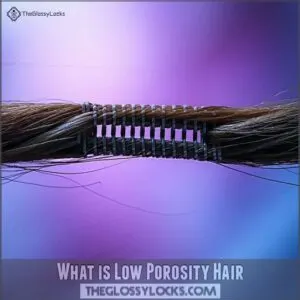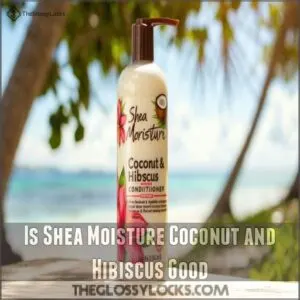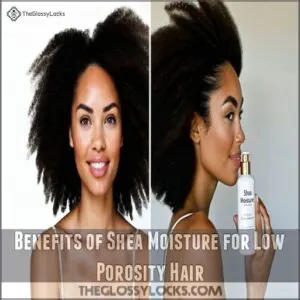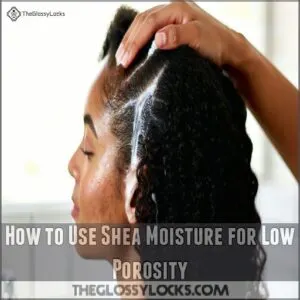This site is supported by our readers. We may earn a commission, at no cost to you, if you purchase through links.
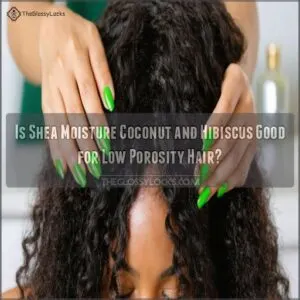
These nourishing formulas are designed to penetrate your tight curl cuticles and deliver intense hydration.
The raw Shea Moisture, Manuka Honey, and Yogurt provide deep conditioning that seals in moisture, while the lightweight coconut oil and hibiscus extracts strengthen your strands without weighing them down.
Just lather up with the co-wash, apply the leave-in conditioner, and you’ll have bouncy, defined curls all day long.
Trust me, your low porosity hair will soak up the goodness.
Now, let’s explore some of the other benefits…
Table Of Contents
- Key Takeaways
- What is Low Porosity Hair
- Is Shea Moisture Coconut and Hibiscus Good
- Benefits of Shea Moisture for Low Porosity Hair
- How to Use Shea Moisture for Low Porosity
- Choosing The Right Shea Moisture Products
- Frequently Asked Questions (FAQs)
- What are Shea moisture low porosity products?
- Does coconut milk help with hair growth?
- Are Shea moisture low porosity shampoo & conditioner worth the money?
- How to choose a hair care product for low porosity hair?
- Is Shea Moisture good for black hair?
- Is Shea Moisture good for dry hair?
- Is coconut hibiscus good for low porosity hair?
- Is hibiscus good for low porosity hair?
- Is Shea Moisture Coconut and Hibiscus good for your hair?
- Is shea good for low porosity hair?
- Will Shea Moisture weigh down my low porosity hair?
- How often should I use Shea Moisture products?
- Can Shea Moisture cause product buildup for low porosity?
- How long does Shea Moisture take to absorb into low porosity hair?
- Does the Coconut and Hibiscus line have enough slip for detangling?
- Conclusion
Key Takeaways
- The Shea Moisture Coconut & Hibiscus line is specially formulated to hydrate and nourish low porosity hair with humectant-rich ingredients that penetrate deep to lock in moisture.
- Coconut oil and hibiscus extract in the Shea Moisture products work together to soften, condition, and add shine to your low porosity locks without weighing them down.
- To get the most out of the Shea Moisture line for low porosity hair, use a coconut oil pre-shampoo treatment, then follow up with the lightweight leave-in conditioner and hydrating hair mask.
- When choosing Shea Moisture products, look for ones containing humectants, lipids, lightweight conditioners, and amino acids to target the unique needs of your low porosity hair.
What is Low Porosity Hair
Are you struggling to get moisture into your hair?
Chances are, you’ve got low porosity hair – that means your hair cuticles are tightly packed, making it tough for moisture and products to penetrate.
But don’t worry, we’ve some tips for you!
Hair Porosity and Curl Pattern
Ever wondered why your hair seems to resist moisture like a waterproof jacket?
It’s all about hair porosity, not just curl pattern.
Low porosity hair features cuticles so tightly packed, water and products struggle to get in.
Style and moisture retention aren’t just challenges—they’re adventures.
Embrace your unique hair type with the right tests and techniques.
Characteristics of Low Porosity Hair
If you have low porosity hair, you probably know it takes forever to get wet and dry. This is because your hair cuticles are tightly packed, making it hard for moisture and products to penetrate. Look for signs like:
- Hair floats on water
- Slow product absorption
- Struggles to hold style
- Extended drying time
Importance of Hair Porosity
Benefits of Shea Moisture for Low Porosity Hair
"Causes of Low Porosity Hair" (What Causes Low Porosity Hair). Use the same guidelines as before, but this time write 80 words.
Causes of Low Porosity Hair
Low porosity hair is usually hereditary.
Excessive product use, heat styling, and environmental factors can also contribute to tightly-packed cuticles over time.
Your hair’s porosity isn’t just a trait – it’s a dynamic characteristic that can change based on what you do and what your hair experiences.
Importance of Hair Porosity
Hair porosity is a big deal in terms of your curls.
See, your hair’s ability to soak up moisture and products depends on how tightly packed those cuticles are.
If you’re struggling with low porosity hair, finding the right products can make all the difference, which is why exploring options like shea moisture low porosity solutions is a great place to start.
Low porosity hair can be a real challenge, but understanding it’s key to healthy, hydrated locks.
Tackle that tricky texture with the right products and techniques, and your hair will thank you.
Is Shea Moisture Coconut and Hibiscus Good
If you have low porosity hair with tightly bound cuticles, making it difficult for moisture to penetrate, you may be looking for products that contain emollients and humectants to help understand low porosity hair. You’re probably wondering if Shea Moisture’s Coconut and Hibiscus line fits into your low porosity hair routine. Great question! Shea Moisture for Low Porosity can be promising, but let’s explore the details.
When seeking the best conditioners for dry hair, look for ones with key ingredients like hydrating oils and butters, such as coconut oil, known for benefits like moisturizing without heavy buildup—important for low porosity hair.
- Lightweight Formulas: The products tend to be more lightweight, which is ideal since your hair easily gets weighed down with heavier products.
- User Reviews: Many product reviews highlight the moisturizing effect without greasy aftermath, a win for low porosity folks.
So, if you’re seeking a balance of moisture and manageability, this line might just complement your unique hair needs! Plus, who doesn’t love feeling like they’re on a tropical getaway with every wash?
Benefits of Shea Moisture for Low Porosity Hair
If your hair struggles with low porosity, you’ll be happy to know that Shea Moisture’s Coconut & Hibiscus line is specifically formulated to quench your strands’ thirst.
These humectant-rich products penetrate deep to lock in moisture, leaving your hair soft, manageable, and oh-so-hydrated.
Humectants and Moisture Retention
Ever wondered why some products just sit on your hair instead of soaking in? Humectants are the secret. They help balance moisture by drawing water into your cuticles.
Here’s a quick look:
| Humectant | Benefit |
|---|---|
| Glycerin | Enhances moisture balance |
| Honey | Boosts water retention |
| Panthenol | Improves product absorption |
These help low porosity hair thrive, even in tricky weather.
Lightweight Conditioners for Low Porosity
For low porosity hair, lightweight conditioners are a game-changer.
Look for formulas that contain humectants like glycerin and lightweight oils that can penetrate those tightly-packed cuticles.
Some top picks include:
- Leave-In Conditioner: Provides continuous hydration without weighing hair down.
- Hydrating Mask: For low porosity hair, using a hydrating mask requires understanding hair moisturizing needs. Deeply conditions hair with a boost of moisture.
- Curl Cream: Helps define curls while keeping frizz at bay.
Coconut Oil and Hibiscus Benefits
Coconut oil and hibiscus are a dream team for low porosity locks.
Coconut oil’s lightweight, penetrating properties soften and condition while hibiscus adds luster and shine.
You can find this powerful duo in various Shea Moisture products available on Shea Moisture Products.
Brimming with vitamins and antioxidants, hibiscus helps strengthen strands and stimulate growth.
Together, these Shea Moisture superstars nourish hair from root to tip for a glossy, healthy look.
How to Use Shea Moisture for Low Porosity
If you’ve got low porosity hair, you’re in luck!
Shea Moisture’s Coconut & Hibiscus line is a great choice for keeping your strands super hydrated.
Start by doing a coconut oil pre-shampoo treatment, then follow up with their leave-in conditioner and hydrating hair mask for seriously soft, manageable locks.
Pre-Shampoo Treatment With Coconut Oil
First, a quick coconut oil pre-shampoo treatment can work wonders for your low porosity hair.
Here’s how:
- Warm a small amount of virgin coconut oil in your palms.
- Gently massage the oil into your scalp and lengths.
- Cover with a shower cap and let it sit for 30 minutes.
- Shampoo as usual to lock in that nourishing coconut goodness.
Leave-in Conditioner and Hydrating Mask
To tackle your low porosity locks, reach for Shea Moisture’s ultra-hydrating leave-in conditioner, available at popular online stores like Shea Moisture Low Porosity, it’ll quench thirsty strands without weighing them down.
And for a more thorough treatment, their coconut and hibiscus mask is a must-try.
Just be sure to limit mask use to 1-2 times per week to avoid product buildup.
Using Hibiscus as a Hair Rinse
Using Shea Moisture‘s coconut and hibiscus products as a hair rinse is a fantastic way to nourish your low porosity strands.
This natural powerhouse:
- Infuses hair with deep conditioning,
- Promotes healthy hair growth, and
- Imparts a radiant shine.
Unlike high porosity hair that may not benefit from shea butter due to its tendency to lose moisture quickly shea butter for high porosity hair.
Simply steep the dried hibiscus flowers, let it cool, and rinse through your hair after shampooing.
Your locks will drink up the hydration and be left looking luscious.
Choosing The Right Shea Moisture Products
When you’ve got low porosity hair, finding the right products is key.
Luckily, the Shea Moisture line offers a range of options that can help lock in moisture and keep your curls looking their best.
Key Ingredients for Low Porosity Hair
You’ve just tackled using Shea Moisture for low porosity hair. Now, let’s chat about key ingredients that make a difference.
Look for products containing these essentials:
| Ingredient | Benefit |
|---|---|
| Humectants | Attract moisture |
| Lipids | Lock in hydration |
| Lightweight Conditioners | Prevent buildup |
| Cationic Surfactants | Smooth cuticles and reduce frizz |
| Amino Acids | Strengthen hair, reduce breakage |
These powerhouse components help your hair stay happy and healthy!
Product Recommendations for Low Porosity
When choosing Shea Moisture products for low porosity hair, look for options with humectants like honey or glycerin to attract and lock in moisture.
Lightweight conditioners with cationic surfactants like cetrimonium chloride can help smooth the cuticle and reduce frizz.
Some top picks include Shea Moisture Protein-Free Leave-In Detangler, Baobab and Tea Tree Oils Low Porosity Conditioner, and Curl Love Moisture Milk.
Shea Moisture Weightless Hydrating Detangler Review
Checking out Shea Moisture’s Weightless Hydrating Detangler might be just what your low porosity hair needs.
This product promises to smoothly work through knots without weighing your hair down, perfect for tighter cuticles.
Its lightweight formula enhances moisture retention without buildup, making detangling a breeze.
Plus, it’s like having a trusty sidekick in your haircare routine!
Frequently Asked Questions (FAQs)
What are Shea moisture low porosity products?
Shea Moisture offers a range of products for low porosity hair, like their Coconut & Hibiscus line.
These include a gentle shampoo, a deeply moisturizing conditioner, and a softening curl enhancing smoothie – all formulated to penetrate and hydrate low porosity strands.
Does coconut milk help with hair growth?
Like a nourishing hug for your locks, coconut milk can be a hair growth superstar.
Coconut milk is rich in fatty acids and vitamins.
These nutrients deeply hydrate strands, promoting stronger, longer, and healthier hair.
Give it a try – your tresses will thank you!
Are Shea moisture low porosity shampoo & conditioner worth the money?
If you’ve got low porosity hair, the Shea Moisture Low Porosity line can be a game-changer.
The shampoo and conditioner are formulated to penetrate and hydrate your hair without weighing it down.
Worth a try for sure!
How to choose a hair care product for low porosity hair?
When choosing hair care for low porosity hair, first understand that low porosity hair has tightly packed cuticles, making it difficult for moisture and products to penetrate, as seen in the low porosity hair guide. Look for lightweight, penetrating ingredients like humectants, lipids, and amino acids.
Avoid heavy, buttery products that could sit on the surface and cause buildup.
Focus on finding the right balance for your unique hair needs.
Is Shea Moisture good for black hair?
Shea Moisture’s coconut and hibiscus line is a great choice for black hair, delivering intense moisture and nourishment. The lightweight formula absorbs easily, leaving your strands soft, strong, and manageable.
Is Shea Moisture good for dry hair?
Take it from me – Shea Moisture’s Coconut & Hibiscus line is a lifesaver for dry hair.
The nourishing blend of coconut oil and hibiscus locks in moisture,
leaving your locks soft, silky, and oh-so healthy.
Is coconut hibiscus good for low porosity hair?
Coconut and hibiscus in Shea Moisture products can work well for low porosity hair.
But it really depends on your specific hair needs.
Try a sample first to see how your locks respond.
Is hibiscus good for low porosity hair?
75% of low porosity naturals say hibiscus is their secret weapon.
Hibiscus‘s lightweight oils and humectants strengthen strands while gently opening cuticles for better moisture absorption.
Definitely give it a try if you struggle with dryness.
Is Shea Moisture Coconut and Hibiscus good for your hair?
The Shea Moisture Coconut & Hibiscus line can be great for your hair, but it really depends on your hair’s porosity.
If you have low porosity hair, this formula may not penetrate as deeply as you’d like.
Is shea good for low porosity hair?
Shea Moisture’s Coconut & Hibiscus line can be a great option for those with low porosity hair.
The lightweight moisturizing formula helps hydrate without weighing down your strands.
Just be sure to pair it with other products designed for your hair’s needs.
Will Shea Moisture weigh down my low porosity hair?
Think of your low porosity hair like an exclusive club – Shea Moisture’s rich, creamy formulas may be the bouncer, denying entry to the moisture your strands crave.
Opt for lighter, penetrating products instead.
How often should I use Shea Moisture products?
Experts recommend using products with intense hydration like Cantu’s shea butter-based curl activator Cantu Leave-In Conditioning Repair Cream for low porosity hair. Experts recommend using Shea Moisture products 2-3 times a week for low porosity hair.
This balanced approach helps retain moisture without weighing down your strands.
Pay attention to how your hair responds and adjust as needed.
Can Shea Moisture cause product buildup for low porosity?
Whether Shea Moisture coconut and hibiscus products work for your low porosity hair really depends on your individual hair needs.
Like a glove, certain formulas might fit you just right – or leave you feeling a tad snug.
How long does Shea Moisture take to absorb into low porosity hair?
Shea Moisture products can take a bit longer to absorb into low porosity hair since the tightly sealed cuticles make it harder for moisture to penetrate.
Give those nourishing ingredients some extra time to soak in for best results.
Does the Coconut and Hibiscus line have enough slip for detangling?
Feels like gliding through silk!
The Coconut & Hibiscus line packs serious slip, making detangling a breeze for your low porosity locks.
Just rake it through and watch those knots melt away.
Conclusion
Incredibly, up to 90% of Black women struggle with low porosity hair.
Luckily, Shea Moisture’s Coconut and Hibiscus line is a game-changer for tackling this challenge.
With its nourishing blend of raw Shea, Manuka Honey, and Yogurt, this range deeply conditions low porosity hair while coconut oil and hibiscus extracts strengthen strands without weighing them down.
By incorporating these products into your routine, you’ll achieve the bouncy, defined curls you crave.

